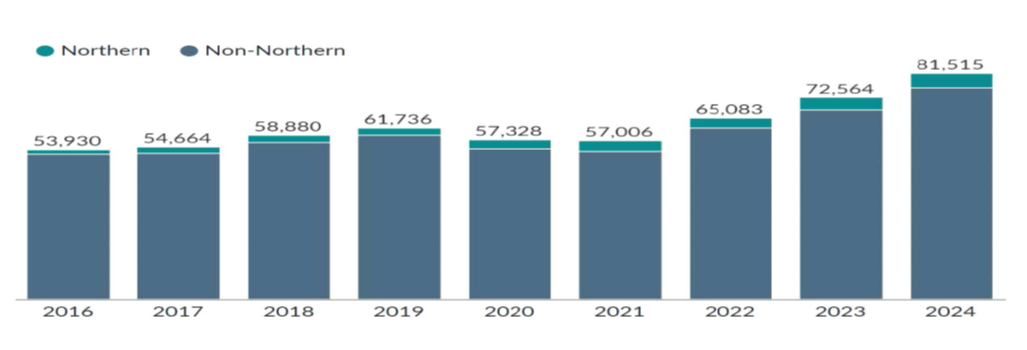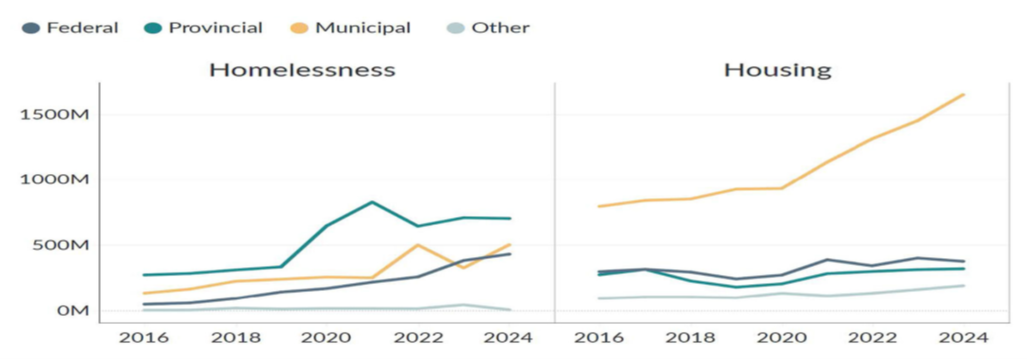Collaborating to Tackle Homelessness in Ontario
Collaborating to Tackle Homelessness in Ontario with Data
By: Michael Jacek, Adrienne Jugley, and Fern Dominelli
May 2025

The Association of Municipalities of Ontario (AMO), the Ontario Municipal Social Services Association (OMSSA), and the Northern Ontario Service Deliverers Association (NOSDA) partnered together and commissioned HelpSeeker Technologies to undertake this ground breaking research project with the full participation with all 47 municipal Service System Managers. It also represented an evolution of the relationship between the three associations and their memberships to formally collaborate on a project of this magnitude. It demonstrated what can be accomplished together with common purpose.
OMSSA, NOSDA, and AMO initiated the study for several reasons. Data is essential to aid evidence-informed public policy development and sustained advocacy. Before this ambitious research study, comprehensive profile of the current and future state of homelessness in Ontario did not exist. As well, there was not a comprehensive assessment of need, identification of the solutions required and cost estimates of what it would take to end chronic homelessness.
Municipalities Under Pressure
As we know, the municipal sector is directly feeling the pressures of responding to the growing scale, scope, and complexity of homelessness. We recognized that we must understand the problem first to have an informed conversation about the solutions required and the amount of investment needed to implement them. Homelessness is a truly wicked societal problem taking a devastating toll on people and communities; however, it is not unsolvable.
The project’s three key objectives were to:
- Quantify the current scale and scope of homelessness in Ontario as well as potential growth without additional interventions.
- Identify and cost solutions at a provincial level to end chronic homelessness in Ontario to a functional zero standard, as defined by the Canadian Alliance to End Homelessness’s Built for Zero initiative.
- Identify the gap between current municipal, provincial, and federal investments and the required investments to end chronic homelessness in Ontario.
The study drew from a range of information sources, primarily existing administrative data from municipal Service Managers and other statistical data sets from the Federal and Provincial governments to complete the modelling. Data collected from CMSMs and DSSABs included the number of homeless people in Ontario communities, service usage, performance indicators and program expenditures. To complete the financial analysis, data was collected about all levels of government's funding revenue and municipal expenditures on homelessness and housing services. Detailed information about the methodology and data sources are outlined throughout the report.
Major Findings and Implications: New, Surprising and Shocking
The report outlined major findings. It validated what municipal Service Managers knew was already happening on the ground. However, much was new, surprising and shocking. The study confirmed that the homelessness crisis in Ontario is severe and getting worse. More than 80,000 Ontarians were known to be homeless in 2024, a number that has grown by more than 25% since 2022.
Put in perspective, this is approximately the population of a mid-sized city like the City of Peterborough. More than half of this total are chronically homeless, characterized by prolonged or repeated episodes. This is a critical indicator of the breakdown in the homeless response system.
 |
| People Experiencing Homelessness |
Most homeless individuals live in urban centres in Southern Ontario, but homelessness is increasing fastest in rural and northern communities. In rural communities, homelessness has grown by more than 150% since 2016, compared to an average of about 50% across all communities. In Northern Ontario, homelessness has risen by an estimated 204% since 2016, more than four times faster than in Southern Ontario over the same time.
Different groups of people are disproportionately impacted by homelessness. While the majority of those experiencing homelessness are adults, nearly one quarter of chronically homeless Ontarians are children (0-15) or youth (16-24). This is cause for concern. Refugee homelessness has grown more than 600% in four years, while the number of chronically homeless immigrants has doubled in the same period.
Almost 50% of the chronic homeless population in some Service Manager areas are Indigenous, reflecting the enduring effects of colonialism. In some cities and towns, the proportion reaches upwards of 80% mostly in Northern Ontario. All orders of government have a responsibility to work together in the spirit of Reconciliation to commit meaningful resources to advance homelessness solutions that are co-developed and led by Indigenous People, recognizing that most Indigenous people live in urban and rural communities.
Municipalities Doing Their Part
The data clearly demonstrated that municipalities have stepped in to address homelessness in their communities despite limited resources. Municipal spending on homelessness and housing programs has sky-rocketed since 2020, growing to more than $2.1 billion in 2024.
 |
| Government Spending on Homelessness and Housing in Ontario |
The situation will only get worse if we do not act. Without additional interventions, homelessness will continue to increase. Even under a steady economic scenario, homelessness in Ontario could double over the next 10 years and could grow to almost 300,000 people in an economic downturn.
An Unacceptable Situation
The bottom line is that the scale and scope of homelessness described in this report is unacceptable in Ontario. To end chronic homelessness, we need a fundamentally new approach that prioritizes long-term housing solutions over temporary emergency measures and enforcement-based responses.
Solutions to Tackle Homelessness
The report modelling showed that an additional $11 billion over 10 years, would re-focus investments into capital, increase focus on prevention, and create more than 75,000 new affordable and supportive housing units to end chronic homelessness. This approach would prevent people from becoming chronically homeless by creating stable exits to housing.
To tackle the immediate priority of ensuring all encampment residents are appropriately housed, an investment of $2 billion would greatly increase the capacity of support services and supportive, transitional and community housing, and move people into stable housing. Through collective and strategic action, we can make our communities safer, improve quality of life, reduce costs and improve local economies.
In the end, the study has proven to be a valuable resource for understanding homelessness in Ontario. It has filled in critical data gaps related to homelessness and supports AMO. OMSSA and NOSDA’s work on this key priority. This is the most comprehensive profile of homelessness that has ever been produced for Ontario.
The data has is enhancing evidence-informed advocacy for an urgent need for solutions to the homelessness crisis. Insights from the key findings have the potential to inform policy discussions with the provincial government across ministries. Providing municipalities and District Social Service Administration Boards with data can also be used to inform local approaches and advocacy.
Overall, it was a successfully executed project. The key to this was the leadership exercised from OMSSA, NOSDA, and AMO working with common purpose, as well as the expertise of the consultant undertaking the research, HelpSeeker Technologies. This collaborative effort with all the partners paid off.
All 47 municipal Service Managers contributed data for the project, in response to a very comprehensive survey exercise. They did the heavy lifting for the success of this project through their participation and sharing of local data. Municipal staff were invaluable partners in helping to develop the methodology.
There were certainly learnings from the project. The value of the research was affirmed; however, it is not sustainable for AMO, OMSSA, and NOSDA to continue providing ongoing updates and analysis without provincial support. There is a need for more work for a province-wide data framework and strategy to build capacity and increase data consistency and quality. A critical future step is to work on how to more accurately profile Indigenous homelessness with Indigenous partners and to generate and support Indigenous-led solutions.
The research is underpinning continuing policy and advocacy efforts for OMSSA, NOSDA and AMO. The report, found online, will serve as a platform for conversations with the provincial government and has gained traction throughout the sector and in the media.
We’ll close with a big thank you to Service Manager staff who contributed their time, knowledge and data to the project. It could not have been done without you.
About the Authors

Michael Jacek is a Senior Advisor for the Association of Municipalities of Ontario.
Adrienne Jugley is the Interim Executive Director for the Ontario Municipal Social Services Association.
Fern Dominelli is the Executive Director for the Northern Ontario Service Deliverers Association.
Blog categories: Homelessness, Municipal, Data, AMO, NOSDA, OMSSA